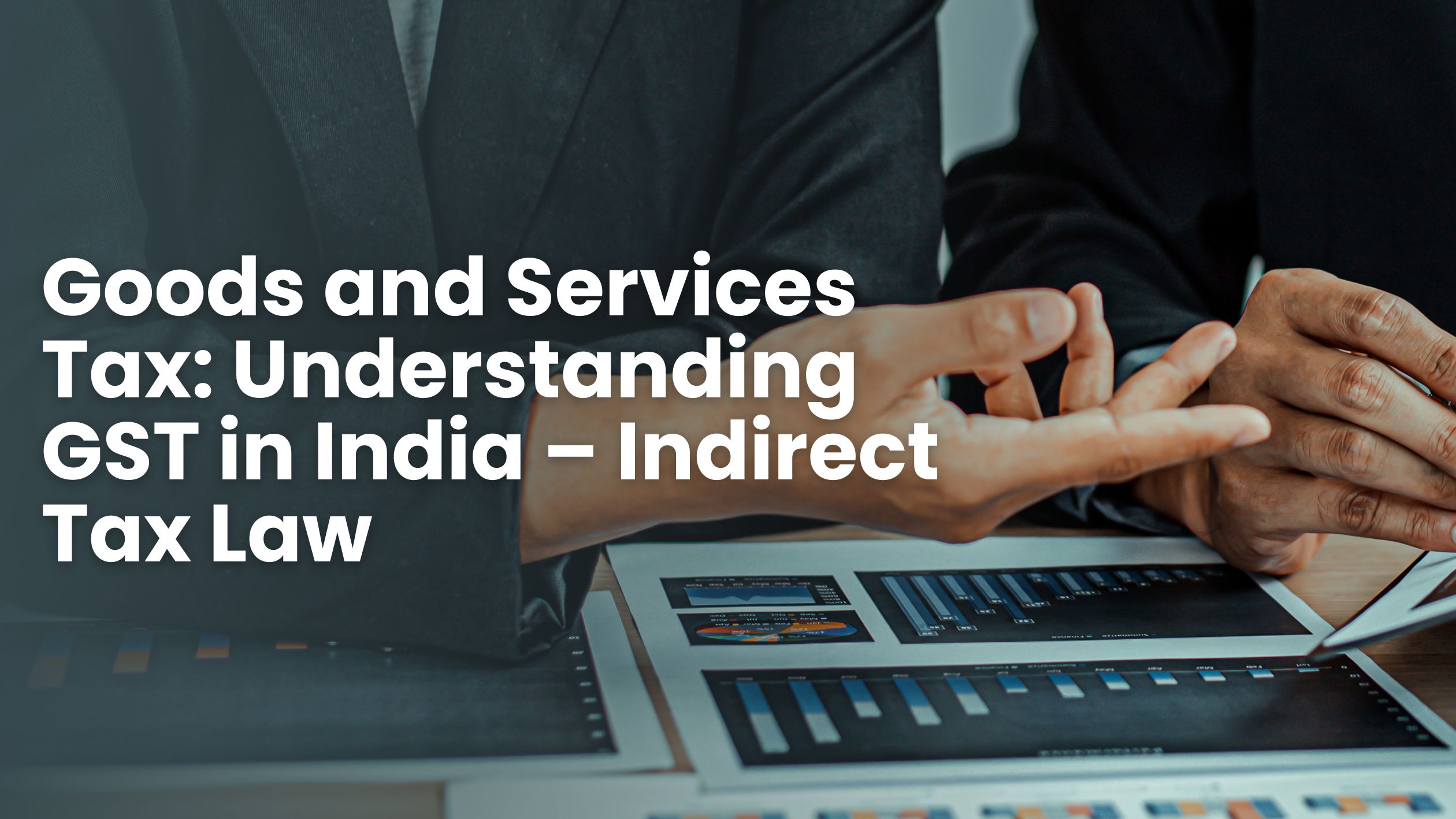What is GST in India?
GST, or Goods and Services Tax, is an indirect tax that replaced several earlier indirect taxes in India, such as excise duty, VAT, and service tax. The Goods and Services Tax Act was approved by Parliament on 29th March 2017 and implemented nationwide on 1st July 2017.
In simple terms, GST is imposed on the supply of goods and services. It is a comprehensive, multi-stage, destination-based tax applied at every stage of value addition. By bringing together most indirect taxes under one umbrella, GST has become the unified domestic indirect tax law across the country.
Indirect Tax Structure Before GST
Prior to the introduction of GST, goods in India were subject to multiple layers of indirect taxation.
Taxation Under the GST System
With the GST framework, tax is charged at every stage of sale. For intra-state transactions, Central GST (CGST) and State GST (SGST) are applied, while inter-state sales attract Integrated GST (IGST).
Multi-Stage Process in GST
An item changes hands multiple times before reaching the consumer, and GST is levied at each step. These stages include:
- Procurement of raw materials
- Manufacturing or production
- Storage of finished goods
- Sale to wholesalers
- Supply to retailers
- Sale to the final consumer
Value Addition
For example, a biscuit manufacturer purchases flour, sugar, and other ingredients. When these raw materials are combined and baked into biscuits, the value of the inputs rises.
The biscuits are then sold to a warehousing agent, who packs them in bulk cartons and adds labels. This process creates another layer of added value. Later, the warehousing agent sells the biscuits to a retailer.
The retailer further enhances the value by repackaging the biscuits into smaller packs and investing in marketing. At every step where value is added, GST is charged on the increase in monetary value until the product reaches the final consumer.
Destination-Based Tax
Suppose goods are produced in Maharashtra but sold to a customer in Karnataka. Since GST is applied at the point of consumption, the tax revenue will be collected by Karnataka, not Maharashtra.
The Evolution of GST in India
The foundation for GST was laid in 2000, when a committee was formed to draft the law. It took 17 years for the framework to be finalized. In 2017, the GST Bill was passed in both houses of Parliament, and the law officially came into effect on 1st July 2017.
Key Milestones in the GST Journey
- 2000 – A committee was set up by PM Vajpayee to prepare a draft GST law
- 2006 – The finance minister announced plans to introduce GST by April 1, 2010
- 2008 – The Empowered Committee finalized a dual GST model with separate levies and legislations
- 2014 – The GST Bill was reintroduced in Parliament by the finance minister
- 2016 – GSTIN became operational
- 2017 – Four supporting GST bills were passed in both houses of Parliament
- 1st July 2017 – GST was officially implemented in India
Objectives of GST
1. To implement the concept of ‘One Nation, One Tax’
GST has replaced the multiple indirect taxes that existed under the earlier tax framework. A single tax structure ensures that all states apply the same rate for specific goods or services. With the Central Government managing tax rates and policies, administration becomes more streamlined. Common systems like e-way bills for goods movement and e-invoicing for reporting transactions can be uniformly applied. It also reduces the burden on taxpayers, as they no longer need to deal with various return forms and deadlines. Overall, GST ensures a unified system of indirect taxation.
2. To merge most indirect taxes in India
Earlier, India had several indirect taxes such as service tax, VAT, and Central Excise, which were imposed at different stages of the supply chain. While some were state levies, others were central levies, and there was no single unified tax on both goods and services. GST brought all major indirect taxes under one framework, reducing the compliance load for taxpayers and simplifying administration for the government.
3. To remove the cascading effect of taxes
A major goal of GST was eliminating the tax-on-tax effect. Earlier, taxpayers could not set off one tax against another—for example, excise duty paid at the manufacturing stage could not be adjusted against VAT payable on sale. This created a cascading burden of taxes. Under GST, tax is charged only on the net value added at each stage of the supply chain, enabling seamless input tax credit across goods and services and removing the cascading effect.
4. To reduce tax evasion
GST has stricter compliance measures compared to older indirect taxes. Input tax credit can only be claimed if the supplier uploads the invoice, preventing misuse through fake claims. The adoption of e-invoicing has further strengthened this safeguard. Since GST operates under a nationwide system with centralised monitoring, defaulters can be tracked more effectively, reducing evasion and fraud.
5. To expand the taxpayer base
GST has increased the number of registered taxpayers in India. Earlier, each tax law had different turnover thresholds for registration. Being a single tax for both goods and services, GST has widened coverage and brought more businesses under the tax net. In addition, stricter compliance rules have helped bring unorganised sectors, such as construction, into the formal system.
6. To enable online processes for ease of business
Previously, taxpayers dealt with multiple authorities under different laws, with assessments and refunds often handled offline. Under GST, almost all processes—from registration to return filing, refunds, and e-way bills—are managed online. This digital approach has significantly improved the ease of doing business and simplified compliance. Plans are also in place to unify all indirect tax requirements through a single centralised portal.
7. To improve logistics and distribution
Having one tax system reduces documentation requirements for goods movement. GST shortens transport cycle times, enhances supply chain efficiency, and allows businesses to consolidate warehouses. The e-way bill system has also led to the removal of interstate checkpoints, making transit smoother and reducing overall logistics and warehousing costs.
8. To encourage competitive pricing and boost consumption
Under the old tax structure, the cascading effect made goods costlier, both within India and compared to global prices. Additionally, varying VAT rates across states created price differences. With uniform GST rates, prices have become more competitive nationwide and internationally. This has increased consumption and in turn boosted indirect tax revenue.
Advantages of GST
One of the major benefits of GST is the removal of the cascading effect of taxes on goods and services. With the elimination of “tax on tax,” the overall cost of goods has come down.
Another key feature is that GST is largely technology-driven. Processes such as registration, return filing, refund applications, and responding to notices are all handled online through the GST portal, which makes compliance faster and more efficient.
Key Advantages of GST:
- Elimination of cascading tax effect
- Higher threshold limits for GST registration
- Availability of composition scheme for small businesses
- Simplified online compliance procedures
- Fewer overall compliances compared to the old regime
- Clear provisions for e-commerce operations
- Better logistics efficiency
- Formalisation and regulation of unorganised sectors
Components of GST
GST is structured into three types of taxes: CGST, SGST/UTGST, and IGST.
- CGST – Collected by the Central Government on intra-state sales (e.g., transactions within Maharashtra).
- SGST/UTGST – Collected by the respective State Government or Union Territory on intra-state sales.
- IGST – Collected by the Central Government on inter-state transactions (e.g., sale from Maharashtra to Tamil Nadu).
Tax Structure Comparison:
| Transaction Type | New Regime (GST) | Old Regime | Revenue Distribution |
| Sale within a State/UT | CGST + SGST/UTGST | VAT + Excise/Service Tax | Revenue shared equally between Centre and State/UT |
| Sale to another State | IGST | CST + Excise/Service Tax | Central Government collects and distributes IGST |
Illustrations:
- A dealer in Gujarat sells goods worth ₹50,000 to a dealer in Punjab. The GST rate is 18% (IGST only). The dealer charges ₹9,000 as IGST, which goes to the Central Government.
- The same dealer sells goods worth ₹50,000 to a consumer in Gujarat at a 12% GST rate. This comprises 6% CGST and 6% SGST. Thus, ₹6,000 is collected as GST, out of which ₹3,000 goes to the Centre and ₹3,000 to the Gujarat Government.
GST Rates in India
GST rates represent the percentage of tax imposed on the supply of goods or services as per the CGST, SGST, and IGST Acts. Any business registered under GST must issue invoices showing the GST charged on the value of supply.
For intra-state transactions, CGST and SGST are levied at approximately equal rates. In the case of inter-state transactions, IGST is charged, which is roughly the combined value of CGST and SGST. Currently, the standard GST slabs applicable to regular taxpayers are 0% (nil-rated), 5%, 12%, 18%, and 28%, with a few special rates such as 3% and 0.25% applied to select goods and services.
Tax Structure Before GST
In the earlier indirect tax regime, multiple indirect taxes were imposed separately by the Centre and the States. States mainly levied VAT (Value Added Tax), and each state had its own set of laws and rules.
For inter-state sales, the Centre levied CST (Central Sales Tax). Along with this, other indirect taxes such as entertainment tax, octroi, and local levies were charged by both state and central authorities, creating overlapping taxation.
For example, when goods were manufactured and sold, excise duty was first imposed by the Centre. On top of that, VAT was charged by the State, resulting in a “tax on tax” situation, also known as the cascading effect.
Taxes Before and After GST
| Taxes Subsumed by GST | Taxes Still Applicable Post-GST |
| Central Excise Duty | Basic Customs Duty |
| Duties of Excise | Tax on Petrol and Diesel |
| Additional Duties of Excise | Tax on Tobacco and Alcohol |
| Additional Duties of Customs | Stamp Duty on Property |
| Special Additional Duty of Customs | Electricity Duty |
| Cess | Vehicle Tax |
| State VAT | Property Tax |
| Central Sales Tax | |
| Purchase Tax | |
| Luxury Tax | |
| Entertainment Tax | |
| Entry Tax | |
| Advertisement Tax | |
| Lottery, Betting & Gambling Taxes |
Note: Certain concessional taxes, such as GST on inter-state purchases at 2% through Form C, continue to apply for specified non-GST goods.
Non-GST Goods Under Concessional Tax
The concessional regime applies to specific goods not covered under GST, such as:
- Petroleum crude
- High-speed diesel
- Petrol (motor spirit)
- Natural gas
- Aviation turbine fuel
- Alcoholic liquor for human consumption
It is applicable only to certain transactions, including:
- Resale
- Manufacturing or processing use
- Specific industries such as telecommunications, mining, and electricity generation or distribution
How Has GST Helped in Price Reduction?
In the pre-GST system, every buyer—including the final consumer—paid tax on tax, a situation known as the cascading effect of taxes.
With GST, this cascading effect has been eliminated. Now, tax is applied only on the value addition at each stage of supply. The system ensures a uniform tax structure across the country, improving tax collection, removing inter-state tax barriers, and supporting economic growth.
Illustration
Tax Calculations in the Earlier Regime:
| Action | Cost (₹) | Tax @10% (₹) | Invoice Total (₹) |
| Manufacturer | 1,000 | 100 | 1,100 |
| Warehouse repack & label (₹300) | 1,400 | 140 | 1,540 |
| Retailer advertises (₹500) | 2,040 | 204 | 2,244 |
| Total | 1,800 | 444 | 2,244 |
Here, tax was charged repeatedly at every stage, raising the final cost to the customer.
Tax Calculations in the GST Regime:
| Action | Cost (₹) | Tax @10% (₹) | Tax Payable (₹) | Invoice Total (₹) |
| Manufacturer | 1,000 | 100 | 100 | 1,100 |
| Warehouse repack & label (₹300) | 1,300 | 130 | 30 | 1,430 |
| Retailer advertises (₹500) | 1,800 | 180 | 50 | 1,980 |
| Total | 1,800 | 180 | 1,980 |
Under GST, input tax credit (ITC) allows taxpayers to claim credit for taxes already paid on inputs. This lowers the net tax liability, reducing the final price for the consumer. In this example, the final price of biscuits drops from ₹2,244 under the old system to ₹1,980 under GST, lessening the burden on the end customer.
What Are the New Compliances Under GST?
Along with online return filing, GST introduced several new compliance systems to streamline processes and strengthen monitoring.
1. e-Way Bills
Launched on 1st April 2018 for inter-state movement and 15th April 2018 for intra-state movement, the e-way bill system created a centralised mechanism for tracking goods. Manufacturers, traders, and transporters can generate e-way bills online, ensuring transparency. It also reduces delays at checkpoints and curbs tax evasion.
2. e-Invoicing
Implemented in phases starting 1st October 2020, e-invoicing is now mandatory (from 1st August 2023) for businesses with turnover exceeding ₹5 crore in any financial year since 2017–18. Each B2B invoice must be uploaded to the GSTN Invoice Registration Portal (IRP) to obtain a unique invoice reference number. The portal validates the invoice, signs it digitally, and issues a QR code.
E-invoicing improves interoperability, reduces manual data entry errors, and ensures invoice data flows directly to the GST portal and e-way bill portal. This eliminates duplicate entry when filing GSTR-1 and simplifies e-way bill generation.
Frequently Asked Questions on GST
1. What is a GST number and how can it be checked?
A GST number, also known as a GST Identification Number (GSTIN), is a unique 15-digit number allotted to every registered taxpayer under the Goods and Services Tax (GST) system. It is PAN-based and serves as a unique identity for businesses.
You can verify a GSTIN through the official GST portal at www.gst.gov.in by using the “Search Taxpayer” option or through reliable GST number search tools.
2. When was GST introduced in India?
The Goods and Services Tax Act was passed in Parliament on 29th March 2017 and was implemented nationwide on 1st July 2017.
3. What does GST mean?
GST stands for Goods and Services Tax. It is a comprehensive indirect tax levied on the supply of goods and services in India, replacing multiple indirect taxes such as VAT, excise duty, and service tax.
4. How many GST slabs are there in India?
Currently, GST in India is divided into multiple tax slabs: 0% (nil-rated), 5%, 12%, 18%, and 28%. Apart from these, there are special rates like 0.25% (for precious stones) and 3% (for gold).
5. What are the GST Acts and rules?
GST is governed by four major Acts:
- Central Goods and Services Tax Act, 2017 (CGST)
- Integrated Goods and Services Tax Act, 2017 (IGST)
- State Goods and Services Tax Act, 2017 (SGST)
- Union Territory Goods and Services Tax Act, 2017 (UTGST)
Additionally, there are detailed rules and notifications issued under these Acts to ensure smooth administration and compliance.
6. Who is required to register under GST?
Any business with an annual turnover exceeding the prescribed threshold (₹40 lakhs for goods, ₹20 lakhs for services; lower for special category states) is required to register under GST. Certain businesses like e-commerce operators and interstate suppliers must register regardless of turnover.
7. What are the benefits of GST registration?
- Legal recognition as a supplier of goods or services
- Collection of tax from customers and passing on the credit of taxes paid
- Input Tax Credit (ITC) benefits
- Eligibility to expand business across states
- Compliance with government laws and avoidance of penalties
8. How can one file GST returns?
GST returns can be filed online through the official GST portal. Registered taxpayers must provide details of their sales, purchases, output tax liability, and input tax credit. Common returns include GSTR-1, GSTR-3B, and GSTR-9 (annual return).
9. What is Input Tax Credit (ITC) in GST?
Input Tax Credit allows businesses to reduce the tax they have already paid on purchases from the tax payable on sales. This helps in eliminating the cascading effect of taxes.
10. What happens if a business does not comply with GST rules?
Non-compliance may lead to:
- Penalties and fines
- Cancellation of GST registration
- Inability to claim Input Tax Credit
- Legal action depending on the severity of default




